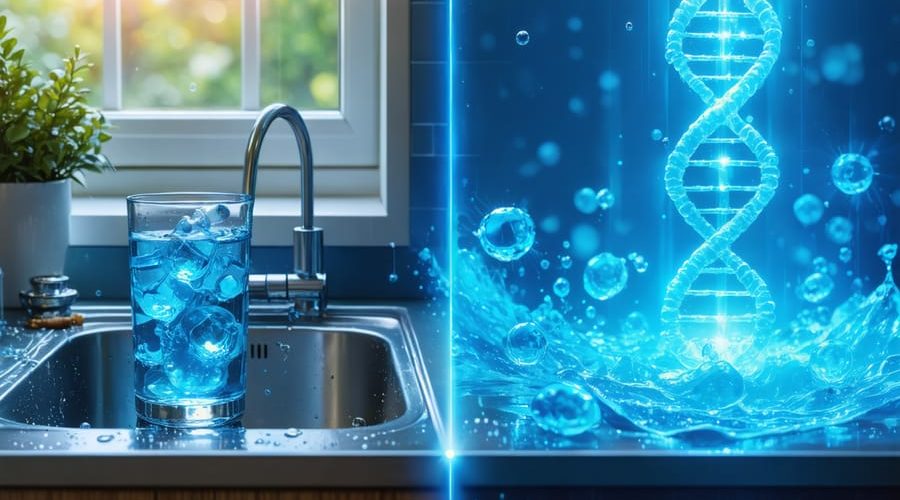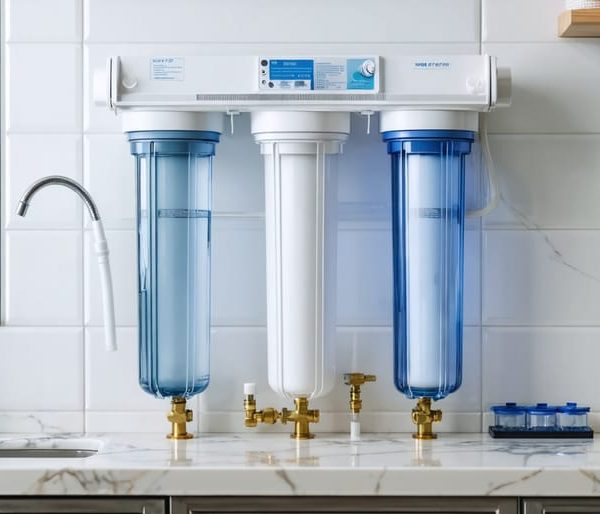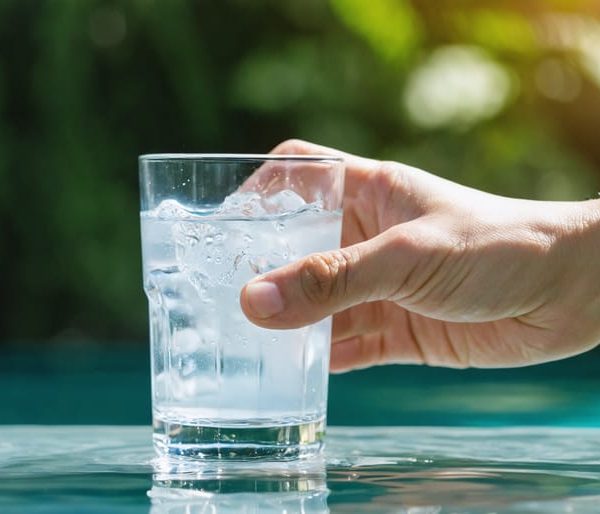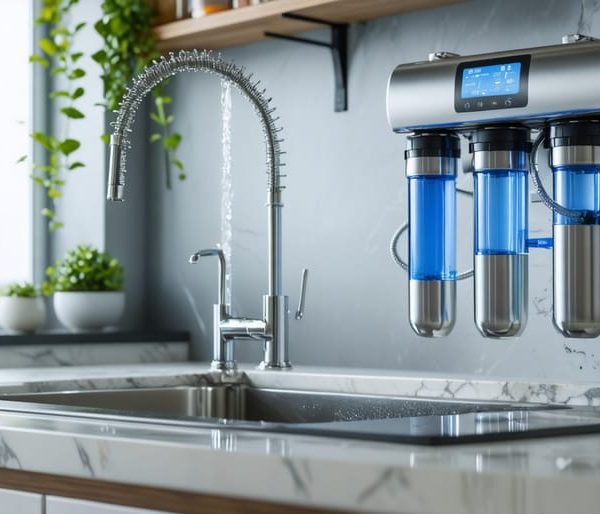Transform your home’s water quality with a whole house UV filtration system – the most advanced defense against waterborne pathogens and contaminants. Beyond standard filtration, UV technology eliminates up to 99.99% of harmful microorganisms without chemicals, delivering crystal-clear, safe water from every tap. As municipalities face increasing water quality challenges, UV water purification benefits extend far beyond drinking water, protecting your family during showers, dishwashing, and laundry.
Modern UV systems integrate seamlessly with existing plumbing while requiring minimal maintenance – just annual lamp replacement and occasional filter changes. Unlike chemical treatments, UV purification leaves no taste, odor, or harmful byproducts, making it an environmentally conscious choice for whole-house protection. The initial investment in a UV filtration system typically pays for itself within 2-3 years through reduced bottled water expenses and improved appliance longevity.
For homeowners seeking complete water security, UV filtration represents the gold standard in comprehensive protection. When paired with sediment and carbon filters, these systems create a multi-barrier approach that addresses virtually every water quality concern, from bacteria and viruses to chlorine and heavy metals.
How UV Light Water Filtration Works
The Science Behind UV Purification
Ultraviolet (UV) purification harnesses the power of light to eliminate harmful microorganisms from your water supply. At its core, the UV filtration process works by exposing water to specific wavelengths of ultraviolet light, typically in the UV-C range (254 nanometers), which is particularly effective at neutralizing waterborne pathogens.
When bacteria, viruses, and other microorganisms pass through the UV chamber, the light penetrates their cell walls and disrupts their DNA structure. This genetic damage prevents them from reproducing and effectively renders them harmless. Think of it as a silent guardian that works without adding any chemicals to your water.
The effectiveness of UV purification depends on several factors, including water clarity, flow rate, and UV lamp intensity. Clear water allows better light penetration, ensuring that microorganisms receive the full dose of UV radiation. The process is incredibly fast, treating water as it flows through the system in mere seconds.
What makes UV purification particularly appealing is its chemical-free nature. Unlike chlorine or other chemical treatments, UV light doesn’t alter your water’s taste, odor, or chemical composition. It’s an environmentally friendly solution that provides powerful protection against waterborne illnesses while maintaining your water’s natural qualities.
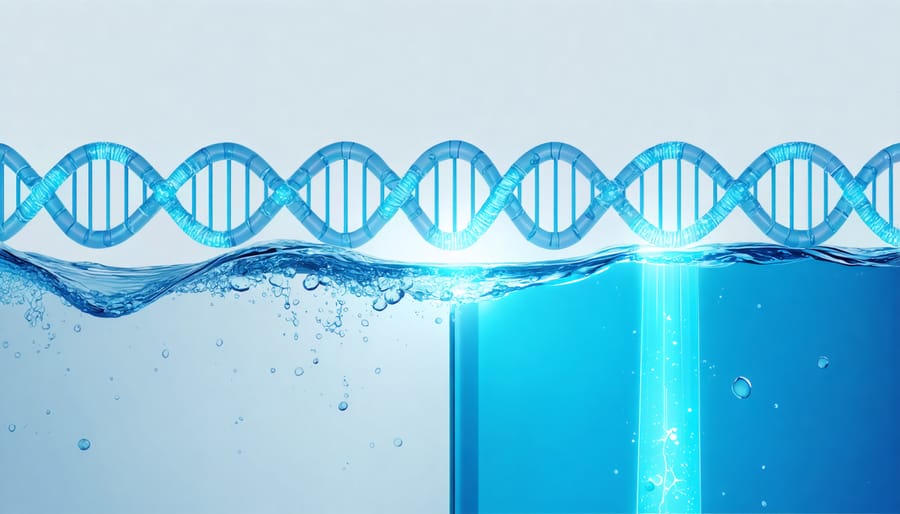
Types of Contaminants UV Light Eliminates
UV light treatment effectively eliminates a wide range of harmful microorganisms from your household water supply. The most common waterborne pathogens neutralized by UV light include bacteria like E. coli, Salmonella, and Legionella, which can cause severe gastrointestinal illnesses and respiratory infections.
Viruses are another significant group of contaminants that UV treatment targets. These include harmful varieties such as Hepatitis A, Norovirus, and Rotavirus, which are particularly concerning because they’re too small to be caught by standard filtration methods alone.
UV light also destroys parasitic organisms like Giardia and Cryptosporidium, which are resistant to many chemical treatments. These parasites can cause serious digestive issues and are particularly dangerous for individuals with compromised immune systems.
Additionally, UV treatment is effective against various types of algae and fungi that might be present in your water supply. While these organisms aren’t always harmful, they can affect your water’s taste, smell, and appearance.
What makes UV treatment particularly valuable is its ability to eliminate these contaminants without adding chemicals to your water or altering its natural mineral content. The process works by disrupting the DNA of microorganisms, preventing them from reproducing and effectively rendering them harmless. This natural purification method ensures your household water remains clean and safe while maintaining its original qualities.
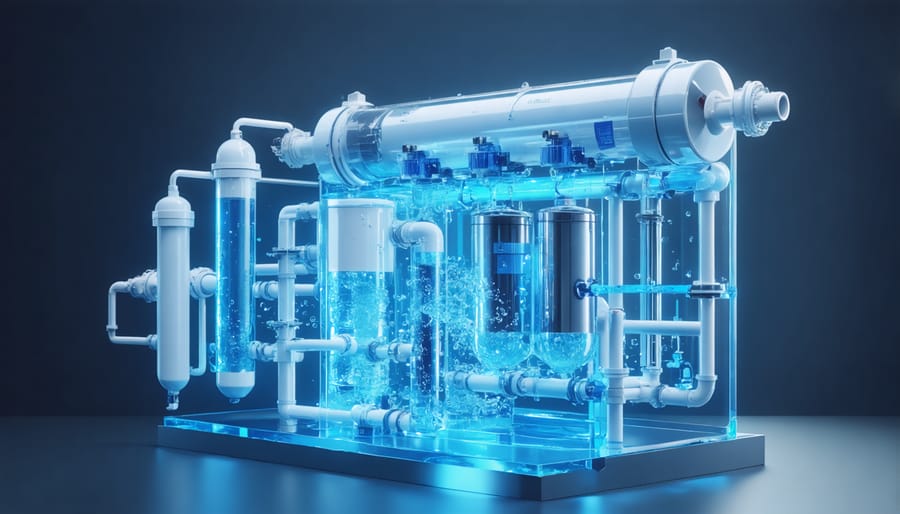
Components of a UV Light Filtration System
Pre-Filtration Requirements
Before UV light can effectively disinfect your water, proper pre-filtration is essential to ensure optimal performance. Think of pre-filtration as preparing the stage for the UV light to perform its best work. This typically involves a two-stage process using sediment and carbon filters.
The first stage requires a sediment filter, which removes larger particles like dirt, rust, and sand from your water supply. These particles can create shadows that shield harmful microorganisms from UV light exposure. Most systems use a filter with a rating between 5 and 20 microns, depending on your water quality. This initial filtration step not only improves UV effectiveness but also protects your plumbing system.
Following sediment filtration, activated carbon filtration serves as the second crucial step. Carbon filters remove chlorine, organic compounds, and other contaminants that can affect water clarity. Clear water is essential because UV light must penetrate the water completely to neutralize harmful microorganisms. Additionally, carbon filtration improves water taste and odor while reducing chemical contaminants.
Regular maintenance of these pre-filters is vital. Most sediment filters need replacement every 6-12 months, while carbon filters typically last 12-18 months, depending on your water usage and quality. Ensuring these pre-filtration components are working correctly will maximize the effectiveness of your UV system and protect your investment in clean, safe drinking water.
UV Chamber and Lamp Specifications
The UV chamber in a whole-house water filtration system typically consists of a stainless steel chamber housing a specialized ultraviolet lamp. These chambers are designed to provide optimal exposure time, ensuring water receives the correct UV dosage for effective disinfection. Most residential UV systems use lamps rated between 25 and 45 watts, capable of treating water flow rates from 8 to 16 gallons per minute – sufficient for average household needs.
The UV lamp itself emits light at a wavelength of 254 nanometers, which is proven most effective for destroying harmful microorganisms. Quality UV systems include a quartz sleeve that protects the lamp while allowing maximum UV light transmission. Many modern units feature smart monitoring systems with LED indicators showing lamp status and replacement needs.
Regular UV lamp maintenance is crucial for system effectiveness. The lamp typically requires replacement every 9,000 hours (approximately one year) of continuous operation, even if it appears to be working. The quartz sleeve should be cleaned quarterly to remove any mineral buildup that might reduce UV light transmission. Most manufacturers recommend installing a pre-filter rated at 5 microns or less to protect the UV chamber from particles that could shield microorganisms from the light.
Premium systems often include automatic shut-off features that prevent untreated water from entering your home if the lamp fails, ensuring consistent protection for your family’s water supply.
Control Systems and Monitoring
Modern whole house water filtration systems with UV light come equipped with sophisticated monitoring systems to ensure optimal performance and water safety. The control panel typically features LED indicators that display the system’s operational status, including UV lamp function, filter life, and water flow rates. A green light usually indicates normal operation, while yellow or red warnings alert you to maintenance needs or potential system issues.
Many systems include automated shutdown features that activate if the UV lamp malfunctions, preventing untreated water from entering your home. Digital displays show real-time water quality measurements and remaining filter life, helping you plan maintenance schedules effectively. Some advanced models even offer smartphone connectivity, allowing you to monitor your system remotely and receive instant notifications about performance changes or maintenance requirements.
Pressure gauges installed before and after the filtration components help identify when filters need replacement by measuring pressure differential. UV intensity sensors continuously monitor the lamp’s effectiveness, ensuring proper disinfection levels are maintained. Some systems also include water quality meters that measure Total Dissolved Solids (TDS) and other key parameters.
For safety and efficiency, most control systems feature automatic flow control valves that maintain optimal water flow rates through the UV chamber, ensuring proper exposure time for effective disinfection. This intelligent monitoring helps maintain consistent water quality while protecting your investment in the system.
Installation and Maintenance Considerations
Professional vs DIY Installation
When it comes to installing a whole house water filtration system with UV light, homeowners have two main options: professional installation or DIY approach. While a UV system installation can be completed by experienced DIY enthusiasts, several factors should influence your decision.
Professional installation offers several advantages. Licensed plumbers understand local building codes, have the necessary tools, and can properly integrate the system with your existing plumbing. They can also identify potential issues before they become problems and ensure optimal system performance. Professional installation typically includes proper sizing, correct placement of components, and thorough testing of the system.
DIY installation can save money on labor costs, but it requires specific skills and knowledge. You’ll need basic plumbing experience, appropriate tools, and a clear understanding of your home’s water system. The installation involves cutting into main water lines, properly mounting filters and UV chambers, and ensuring watertight connections. DIY installers must also carefully follow manufacturer guidelines to maintain warranty coverage.
Key considerations for DIY installation include:
– Access to proper tools and equipment
– Understanding of local plumbing codes
– Ability to shut off main water supply
– Knowledge of proper pipe fitting techniques
– Time commitment for installation and troubleshooting
For most homeowners, professional installation provides peace of mind and ensures the system operates efficiently from day one. However, if you’re experienced with plumbing work and comfortable following detailed instructions, DIY installation can be a rewarding and cost-effective option.
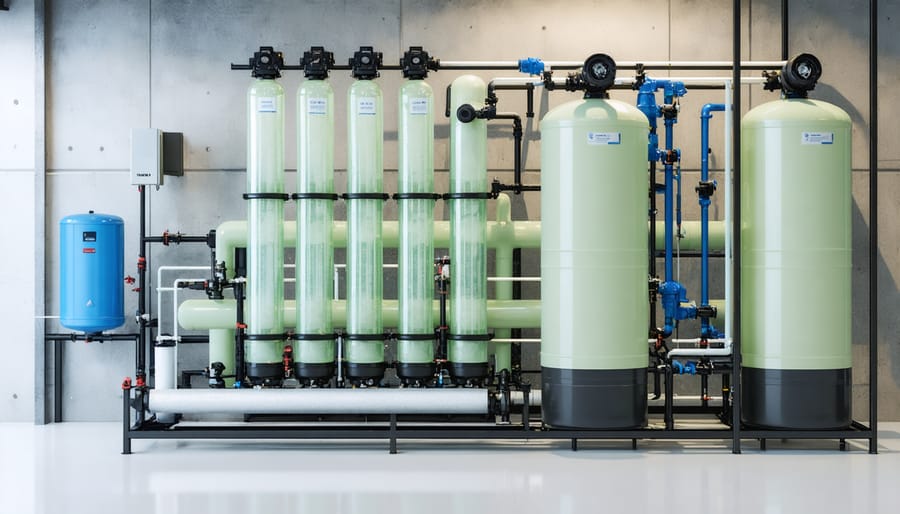
Regular Maintenance Schedule
Maintaining your whole house water filtration system with UV light is essential for optimal performance and longevity. Follow this comprehensive maintenance schedule to ensure your system continues to provide clean, safe water for your household.
Monthly Tasks:
– Visually inspect the system for leaks or unusual noises
– Check UV lamp indicator light for proper operation
– Clean external surfaces with a soft, damp cloth
– Monitor water pressure gauge readings
Quarterly Tasks:
– Replace sediment pre-filters
– Clean filter housings with mild soap and water
– Test water quality using a home testing kit
– Inspect O-rings and gaskets for wear
Semi-Annual Tasks:
– Replace carbon filters
– Clean quartz sleeve of UV chamber
– Check all electrical connections
– Flush the system to remove accumulated debris
Annual Tasks:
– Replace UV lamp (mark replacement date on calendar)
– Replace quartz sleeve if needed
– Test water quality professionally
– Inspect and clean flow restrictors
– Check and tighten all fittings
Emergency Maintenance:
– Replace UV lamp immediately if indicator shows failure
– Address any leaks as soon as they’re detected
– Replace filters early if water pressure drops significantly
Pro Tips:
– Keep spare filters and UV lamp on hand
– Document all maintenance in a logbook
– Set calendar reminders for scheduled maintenance
– Consider professional servicing if unsure about any tasks
Remember that maintenance frequency may vary based on your water quality and usage patterns. Always consult your system’s manual for specific maintenance requirements and safety procedures.
Benefits and Limitations
Environmental Impact
Whole house water filtration systems with UV light offer several environmental advantages compared to UV vs traditional water treatment methods. The system’s primary eco-friendly benefit lies in its chemical-free approach to water purification, eliminating the need for harmful disinfectants that can impact aquatic ecosystems when released into the environment.
From an energy consumption perspective, UV filtration systems are relatively efficient, typically using about the same amount of electricity as a 60-watt light bulb when operating. Most modern units incorporate energy-saving features, such as automatic shut-off mechanisms and smart sensors that optimize power usage based on water flow.
The system’s filter components also contribute to its environmental footprint. While filter cartridges require periodic replacement, many manufacturers now offer recyclable options or take-back programs to minimize waste. The extended lifespan of quality filters, typically lasting 6-12 months, helps reduce the overall environmental impact compared to single-use bottled water alternatives.
Additionally, these systems help reduce plastic waste by eliminating the need for bottled water. A typical household switching to filtered tap water can prevent hundreds of plastic bottles from entering landfills each year. The reduced transportation emissions associated with bottled water delivery also contribute to a smaller carbon footprint.
However, it’s important to note that the environmental benefits must be balanced against the system’s energy requirements and the need for regular filter replacements. Choosing energy-efficient models and properly maintaining the system helps maximize its eco-friendly potential while ensuring optimal performance.
Cost Analysis
Investing in a whole house water filtration system with UV light requires careful consideration of both upfront costs and long-term financial benefits. Initial system costs typically range from $1,000 to $3,000, depending on your home’s size and specific water treatment needs. Professional installation can add another $500 to $1,000 to this investment.
The UV lamp itself costs between $50 to $100 and needs replacement annually, while pre-filters require changing every 6-12 months at approximately $20-50 per filter. The system’s power consumption is relatively modest, adding about $2-4 to your monthly electricity bill.
However, these costs should be weighed against significant long-term savings. A comprehensive filtration system can eliminate the need for bottled water, potentially saving $300-600 annually for an average family. The system also protects your appliances from mineral buildup and damage, extending their lifespan and reducing maintenance costs by approximately $200-400 yearly.
When calculating return on investment, consider that most systems last 10-15 years with proper maintenance. The total cost of ownership over this period, including initial investment, replacement parts, and operating costs, averages $4,000-6,000. This translates to approximately $27-40 per month for clean, safe water throughout your home.
For maximum cost-effectiveness, look for systems with efficient filter designs that don’t require frequent replacements and those with UV lamps featuring automatic shut-off mechanisms to preserve bulb life. Many homeowners find that the initial investment pays for itself within 3-5 years through reduced water expenses and appliance maintenance costs.
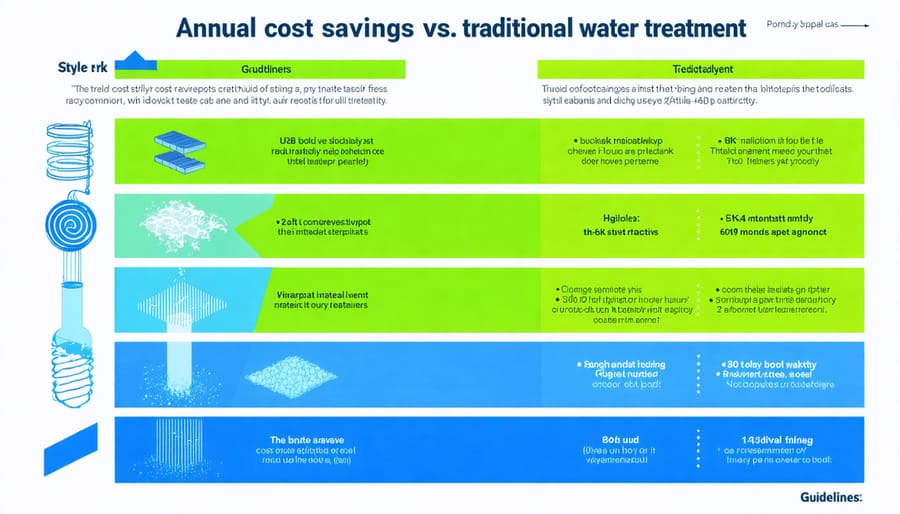
Installing a whole house water filtration system with UV light is a significant step toward ensuring your family’s access to clean, safe water throughout your home. This comprehensive solution not only removes common contaminants through multi-stage filtration but also provides an extra layer of protection against harmful microorganisms through UV disinfection.
As we’ve explored, these systems offer numerous benefits, from improved water taste and odor to protection against waterborne pathogens. The combination of traditional filtration methods with UV technology creates a robust defense against both physical contaminants and biological threats, making it an excellent investment in your home’s water quality.
For homeowners considering this upgrade, here are the key next steps to take:
1. Conduct a water quality test to understand your specific filtration needs
2. Consult with certified water treatment professionals for system recommendations
3. Obtain multiple quotes and compare system specifications
4. Check local regulations and permit requirements
5. Plan for professional installation and regular maintenance
Remember that while the initial investment may seem substantial, the long-term benefits of cleaner, safer water and reduced reliance on bottled water often justify the cost. Regular maintenance, including filter replacements and UV lamp changes, is essential for optimal performance and longevity.
By choosing a whole house water filtration system with UV light, you’re making a conscious decision to protect your family’s health while contributing to environmental sustainability. With proper installation and maintenance, your system will provide years of reliable service and peace of mind knowing that every tap in your home delivers clean, safe water.
